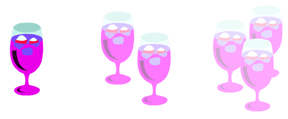Integrally colored concrete countertops can show color inconsistency for a variety of reasons, but the primary cause is lack of ingredient control: One or more of the ingredients in each batch of concrete were not carefully proportioned.
Most often the culprit is water. Adding too much water – often to increase the workability – will alter the color of the concrete, making it lighter than a similar batch that has less water in it.
Think of grape Kool-Aid. The more water you add, the lighter the color will be. The same applies to concrete. (The concrete will also be weaker, just like the Kool-Aid will taste weaker.)

Remember, water is the most critical ingredient in concrete, and casually adding water without keeping track of the exact amount will almost guarantee an inconsistent appearance. To ensure color consistency, ALL of the ingredients, including water, must be accounted for.
The simplest way of doing this is to generate a batch report, where each ingredient amount is listed next to a check box. The batch report ensures consistency in ingredient amounts, and the check boxes ensure that none of the ingredients gets left out.
The CCI mix calculators, both the Precast Concrete Countertop Mix Calculator and the GFRC Concrete Countertop Mix Calculator, print out batch reports. Whatever method you use to calculate your mix, make sure that you are diligent about using batch reports.
